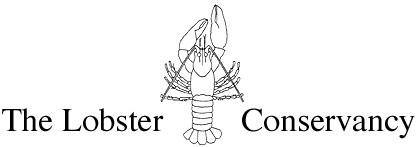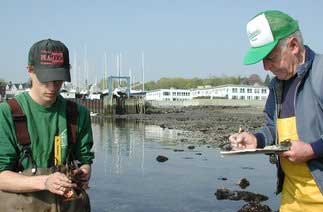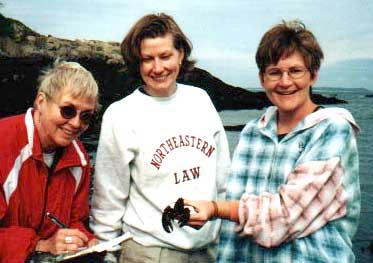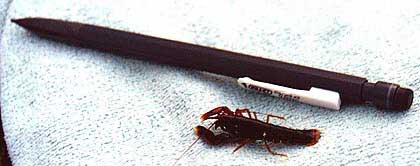
P.O. Box 235, Friendship, ME 04547 (207) 832-8224 www.lobsters.org

P.O. Box 235, Friendship, ME 04547 (207) 832-8224 www.lobsters.org
July 25, 2000
Dear Volunteers and Friends of The Lobster Conservancy,
For those of you who may be unfamiliar with The Lobster Conservancy, our purpose is to ensure healthy populations of the American lobster (Homarus americanus) and preserve the traditional trap fishery that depends on this resource. We are primarily a scientific research organization. This newsletter keeps our volunteer research team informed of our activities.The big news this month is that the first postlarval settlement of the year has been reported and a new nursery hotspot has been identified in Massachusetts! Things are looking good.
Research News
Volunteer Program
The third month of Baby Lobster Watch 2000 was exciting, with volunteers finding high densities of lobsters at many sites, and new volunteers joining the program in Maine and New Hampshire. We now have 57 volunteers and 25 monitoring sites from Manomet Point, Massachusetts to Isle au Haut, Maine. This month also marks the beginning of a pilot program in which several volunteers are entering their own data into Excel spreadsheets and sending it electronically to TLC.
In Massachusetts, Oddvar Solstad and Sean Sullivan of Marblehead were thrilled to report that they found 47 lobsters in 20 quadrats, yielding a density of 2.4 lobsters per square meter.

Sean Sullivan (left) and Oddvar Solstad have been monitoring lobster a hotspot in Marblehead, Massachusetts. Photo by Dennis Curtin.
This is the highest density recorded so far at any monitoring site other than our sentinel site, Lowell's Cove, which indicates that Marblehead is a real hotspot for baby lobsters. The size of lobsters in Marblehead ranged from recent settlers (11 and 12 mm carapace length (CL)) to a nearly legal-sized lobster (80 mm CL). In Gloucester, Pat Earle, Astrid af Klinteberg, and Cindy Dunn also found signs of settlement at Plum Cove, where they measured 22 lobsters (12-75 mm CL) and noted another 2 hiding under massive rocks. Chad Keith and Heather Sagar broke their unlucky streak by finally finding 1 lobster at Manomet Point, but they are considering scouting around for a more productive site.

Pat Earle, Astrid af Klinteberg, and Cindy Dunn sample juvenile lobsters in Lanesville, Massachusetts. Photo by Sara Ellis
In New Hampshire, experienced volunteer Al Stewart trained Michele Swisher, Jean Willcox and Mary-Louise Knopp how to sample for juvenile lobsters. Next month this new team will start monitoring on their own, by scouting out Concord Point in Rye. In New Castle, Brian Jervis, and John and Carolyn Payzant uncovered 11 lobsters (31-55 mm CL), 3 of which were too wily to capture. At Odiorne Point State Park, Timothea Jousse and Julie Ligon found 2 lobsters on their transect and another 2 while searching randomly (total range 35-65 mm CL), before being inundated by 20 tide-pooling school children.
In Southern Maine, Bryan Watson found 19 lobsters (31-80 mm CL) in 8 quadrats at Wells Beach, which actually ties this month's record density of 2.4 lobsters per square meter. Enid White and Patrice Farrey found 30 lobsters at Lobster Cove, York while searching randomly for the best site to set up a transect next month. They found recent settlers, with several lobsters between 9 and 14 mm CL, while the largest juvenile was 69 mm CL. They also found an intact molt shell (41 mm CL) with a newly molted lobster (50 mm CL), indicating that it grew 9 mm in one molt.
In Western Casco Bay, Helen Muther along with Mike Doan, Meaghan Murphy and Alida Payson of Friends of Casco Bay were hoping to match their June total of 14 lobsters in Broad Cove, Cape Elizabeth. Needless to say, they were ecstatic when they ended up finding 21 lobsters (29-71 mm CL)! Elsewhere on Cape Elizabeth, Sara trained Professor Jack Ney of Southern Maine Technical College and Odessa Bedard to monitor a promising looking nursery ground, locally known as Sprout's Cove. On Chebeague Island, Mac Passano, Beth Howe and Erno Bonebakker went back to Bennett's Cove where they found 4 lobsters. Fellow Chebeaguers Carol White, Jim Millinger, and Bob Putnam are looking for more productive sites on nearby islands.
In Eastern Casco Bay Corie Bibber Logan sampled 21 lobsters (14-44 mm CL) at Little Harbor and another 5 (14-43 mm CL) in Mackerel Cove. Kristine Osolin turned up 8 lobsters (13-50 mm CL) at her monitoring site on Pott's Point, while her parents, Ned and Kathy, sampled 14 lobsters out on Jaquish Island (25-50 mm CL). At Cundy's Harbor, Amy Watson found 7 lobsters (17-52 mm CL), including one that taunted her from under a rock too big to move. (For more on Casco Bay, see Lowell's Cove, below.)
In Muscongus Bay, Michael Wall discovered 26 juvenile lobsters ranging in size from 29-56 mm carapace length, along his two 10-meter transects. (For more on Muscongus Bay, see Friendship Long Island, below.)
In Penobscot Bay, Jane Roundy and Julie Wortman were dismayed to find that many rocks in the intertidal zone at Drift Inn Beach had been overturned and left that way, especially rocks where they normally find lobsters. They also discovered a dead lobster wedged among some high rocks. They recorded only 9 lobsters (28-50 mm CL), which was fewer than last month, and they fear that human disturbance was responsible for this decrease. Lobsterman Alfred Petterson teamed up with Leslie Fuller, Nancy Light and Chris Fichtel to monitor Waterman Point, where they found 11 lobsters (34-68 mm CL). On Isle au Haut, high school student Kipp Quinby showed her father David the ropes, since she will soon be heading for Finland for a year to learn first-hand about a different culture. At Moore's Harbor, the Quinby team found 7 lobsters, ranging from 16-61 mm CL. On Vinalhaven, John and Ginger Van Ness found 10 lobsters (30-70 mm CL) in rocky intertidal habitat and another 5 (40-52 mm CL) in eel grass beds, before getting caught by the incoming tide.

Volunteers must have eagle eyes to spot tiny lobsters like this one. Photo by Sara Ellis
Long-term Tagging of Juvenile Lobsters
On Friendship Long Island, we caught 35 lobsters in 22 quadrats, yielding approximately 1.6 lobsters per meter squared. Two of the 35 lobsters tagged this month had been captured by us earlier this year – as evidenced by the presence of an implanted tag. Many parts of cast molt shells were seen and some molting activity was recorded. The lobsters ranging in size from 15-75 millimeters in carapace length are estimated to be between one and six years old.
At Lowell's Cove, Polly Wilson, Anne Barrett, and Bridget Murphy helped Sara and Diane cover three transects. In all, 76 lobsters were captured in 48 quadrats, yielding a density of approximately 1.6 lobsters per meter squared. These lobsters ranged from 11-52 millimeters in carapace length. The smallest lobster is thought to be less than one year old and the largest approximately four or five years old. Three lobsters captured at Lowell's Cove had been previously tagged – one in 1998 and the other two in 1999. Molting activity was less prominent at Lowell's Cove this month than it was in June.
Lobster Life Study Center
The Lobster Conservancy is currently establishing the Lobster Life Study Center as the first marine research facility dedicated solely to projects promoting the health of lobster stocks. The Lobster Life Study Center is located at the lobster pound on Friendship Long Island in Knox County, Maine – the region of the highest lobster landings in the United States. Here, scientists will collaborate with lobster fishers to investigate the major events in the life cycle of the American lobster: from egg to plate. Initial studies at the Lobster Science Center will focus on reproductive biology because propagation is fundamental to perpetuating a healthy fishery.
Professor Joseph Kunkel and his research assistant, Gerda Kunkel, of the University of Massachusetts at Amherst, visited the Lobster Life Study Center to begin analyzing lobster serum proteins. The primary objective of our collaborative research efforts are to determine the health and reproductive condition of lobsters based on what is circulating in their hemolymph (lobster blood/lymphatic fluid). Professor Kunkel analyzes samples taken from lobsters at the pound, while TLC scientists keep track of the progress of the individually marked lobsters as they progress through their molting, breeding and brooding cycles. Ultimately, this research will lead to a method for collecting instantaneous readings of the health and reproductive condition of wild lobsters.
Earlier this month, high school students, Sarah and Tom Arnold of Nobleboro, Maine joined our work force at the lobster pound. Along with intern Tim Dwyer, they have been helping Sara and Diane construct lobster caves, catch food for the lobsters, and record data on the condition of individually tagged lobsters.
Outreach and Education
On July 10, Sara gave a short presentation to Vinalhaven lobstermen and other residents at a roundtable hosted by the Maine Sea Coast Mission and the Island Institute. Sara presented results of the Penobscot Bay Lobster Collaborative along with colleagues Bob Steneck of the University of Maine, and Lew Incze and Rick Wahle of Bigelow Laboratory.
Diane and Sara made a joint presentation at the Martin Point Community House in Friendship, Maine on Wednesday July 19. Approximately 50 audience members attended the event. Diane made an introduction focusing on the importance of the fishery to the local community, then Sara talked about our volunteer monitoring program. Next, Diane presented information about lobster mating systems and related our plans and progress for the Lobster Science Center. The Fishermen's Heritage Lobster Co-op kindly donated a male and female lobster for demonstration purposes.
The Lobster Conservancy continues to provide information to people around the world on lobster biology and our organization through our web site, www.lobsters.org. Many thanks to Al Stewart for keeping the site up-to-date, and to board member Kari Lavalli for maintaining and hosting the biology page.
Upcoming Events
On Saturday, July 29, TLC will be participating in Friendship Day by hosting a touch tank and information table outside 15 Main Street from 8:00-11:00 am. We'll share stories about lobsters and other marine life. Friendship Day is a wonderful community gathering to benefit the Friendship Ambulance Service, with activities scheduled from dawn 'till dusk, including the first annual Lobster Boat Races at 3:30 pm. TLC will be selling its ever-popular hats, and donating a portion of the day's sales to the Friendship Ambulance Service.
End Notes
Do you need a generator, or know someone who does? The Lobster Conservancy has a 35-kilowatt generator for sale, for $3,000. We are also selling an aeration system with 3 large pumps for $3,000 that can be used to aerate lobster pounds or aquaculture facilities. Please call or e-mail for details.
Looking for a new project? We are seeking volunteers to help winterize the Lobster Science Center on Friendship Long Island, by insulating the basement. Come one, come all!!
And finally, one book-keeping note. The Lobster Conservancy has moved from Main Street in Friendship, so please be sure to send mail to our post office box (P.O. Box 235, Friendship, ME 04547). Diane continues to live and work at the Lobster Science Center, while Sara is working from her home office until we locate new headquarters on the mainland. Thanks go to Patricia Seward, Tim Dwyer and Teddy Coates for help with the move.
Yours in TLC and Friendship,
Sara Ellis, Executive Director and Diane Cowan, Senior Scientist